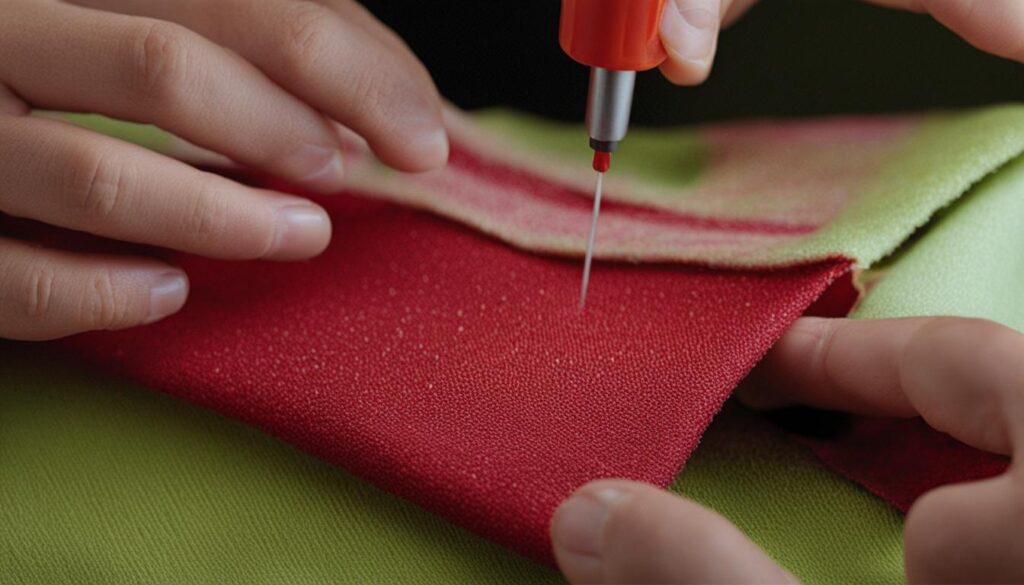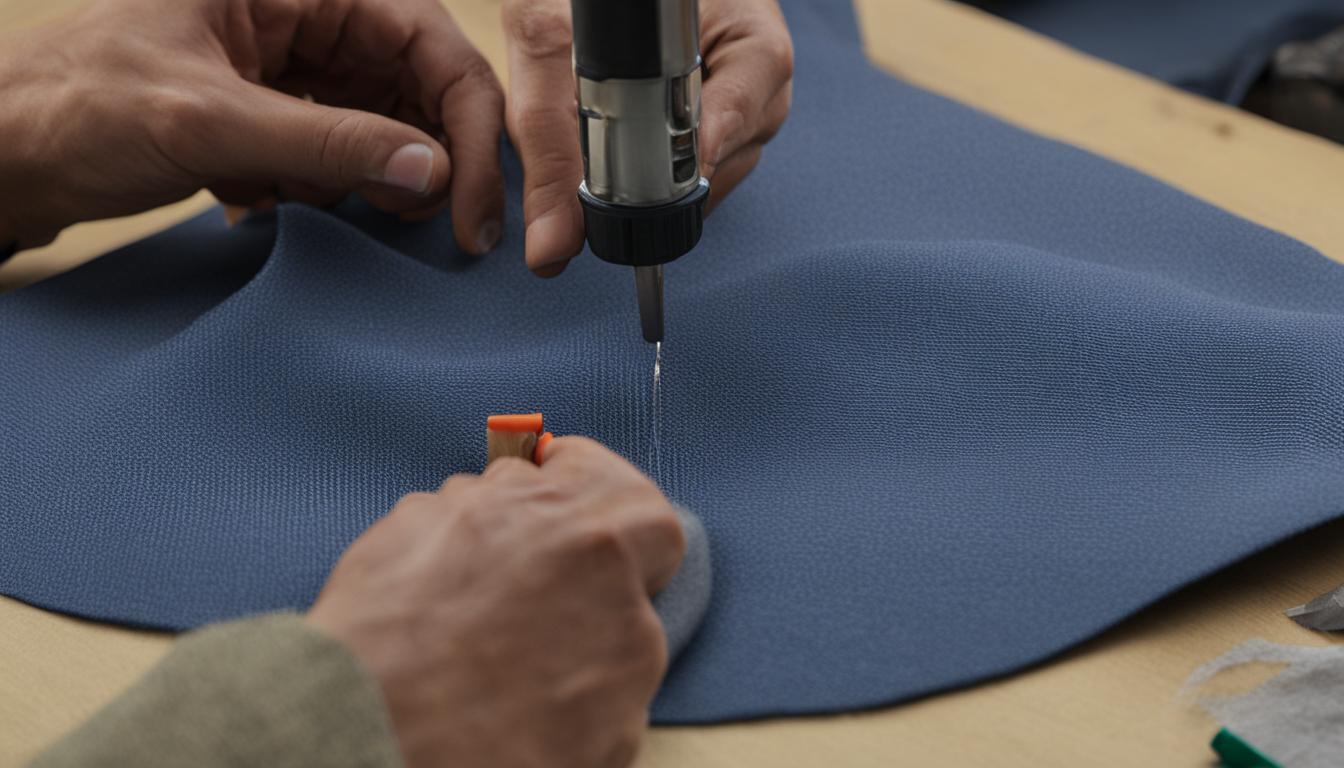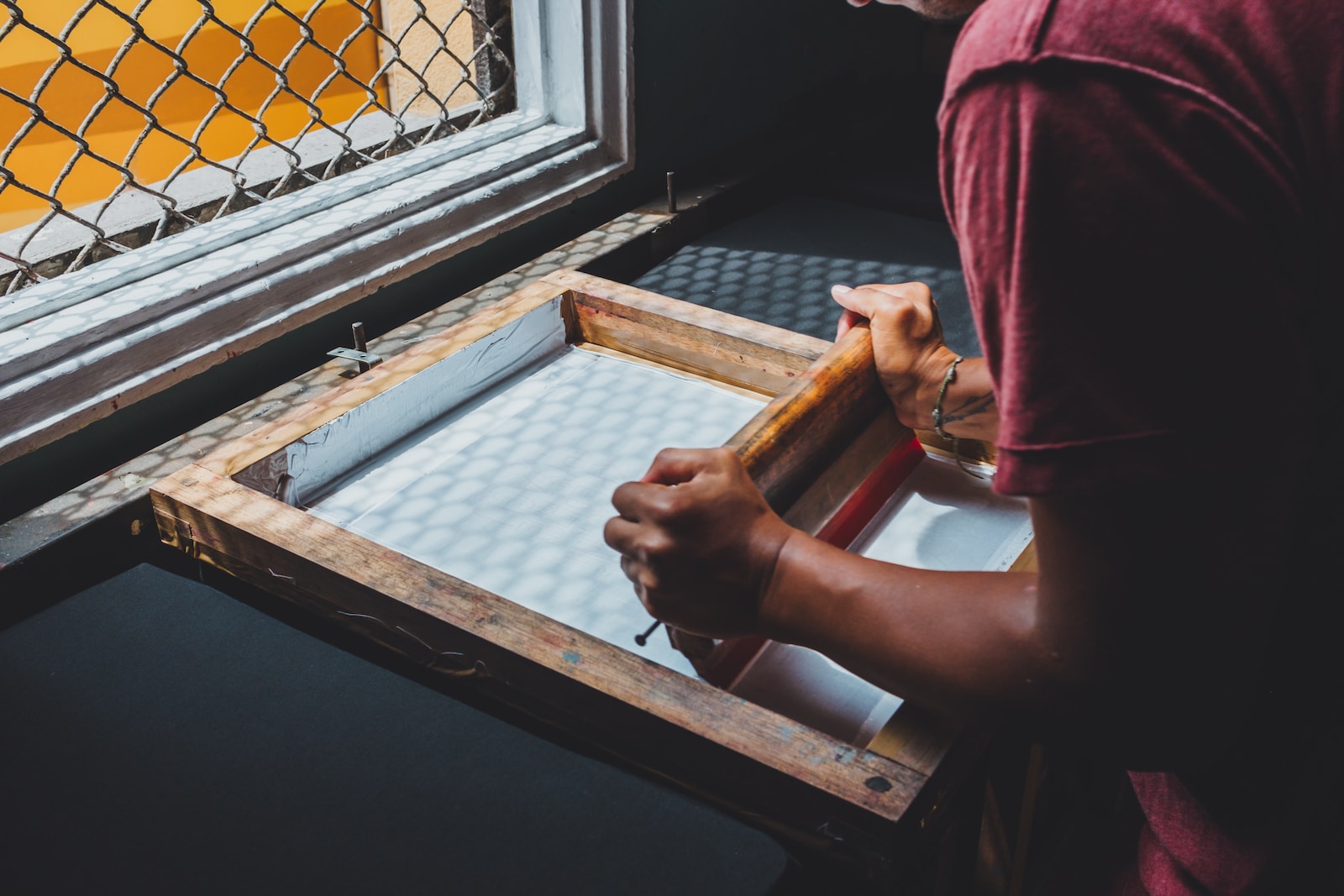Craft glue is an essential item in textile arts, but it’s important to choose the right type for optimal results. Hot glue and fabric glue are two common options for bonding materials in textile projects.
Key Takeaways:
- Hot glue and fabric glue are both used in textile arts for bonding materials.
- Hot glue is a strong adhesive that is heated in a glue gun, while fabric glue is specifically designed for use on fabrics.
- Hot glue is versatile and can be used on a wide range of materials, while fabric glue provides a durable and flexible bond for fabrics.
- Consider the specific requirements of your project when choosing between hot glue and fabric glue.
- Understanding the differences between hot glue and fabric glue can help you choose the most appropriate adhesive for your textile projects.
The Benefits of Hot Glue in Textile Crafts
Hot glue is a versatile adhesive that offers several benefits for textile crafts. Its high viscosity makes it excellent for filling gaps between materials and providing a strong bond. Whether you’re working with fabrics, beads, or other embellishments, hot glue can securely hold them in place. This adhesive’s ability to bond different materials together makes it a popular choice for various textile projects.
One of the key advantages of hot glue is its water-solubility. If you make a mistake or need to reposition your materials, you can easily remove the glue by washing it out. This makes hot glue particularly useful for fabric-based crafts, as it allows for adjustments and modifications without damaging the fabric.
Another benefit of using hot glue is its quick-drying nature. This allows for efficient crafting, as you won’t have to wait for hours for the glue to set. It’s especially handy when working on time-sensitive projects or when you need to complete multiple tasks within a short period. The fast-drying property of hot glue enables you to move swiftly from one step to the next, saving you valuable time.
“Hot glue is my go-to adhesive for textile crafts because of its versatility and quick-drying properties. It’s perfect for securing fabrics, trims, and other embellishments, giving my projects a professional and durable finish.” – Textile Crafter
| Benefits of Hot Glue in Textile Crafts | |
|---|---|
| 1. | Strong bond and gap-filling capabilities |
| 2. | Water-soluble for easy removal and repositioning |
| 3. | Quick-drying, allowing for efficient crafting |
Overall, hot glue is a valuable tool for textile crafts due to its versatility, water-solubility, and quick-drying nature. Whether you’re a beginner or an experienced crafter, hot glue can provide you with the convenience and reliability you need to bring your textile projects to life.

The Advantages of Fabric Glue for Textile Arts
Fabric glue plays a crucial role in textile arts, offering numerous advantages for crafters and artists. Its specifically formulated composition makes it an ideal adhesive for bonding fabrics and enhancing the durability of textile projects. Here are some key advantages of using fabric glue:
- Strong and Flexible Bond: Fabric glue is designed to provide a secure and flexible bond between fabric layers or different fabrics. It ensures that the materials stay together, even with frequent handling or manipulation.
- Non-Toxic and Safe: One of the major advantages of fabric glue is its non-toxic nature, making it safe for use in various textile projects, including those involving children. Crafters can have peace of mind knowing that fabric glue is a safe option for their creations.
- Versatility: Fabric glue can be used on a wide range of fabrics, including delicate silks, lightweight cotton, sturdy denim, and more. Its versatility allows crafters to work with different materials and experiment with various textile art techniques.
While fabric glue offers numerous advantages, it is worth noting that different projects may require different adhesives. It is crucial to consider the specific requirements of your project and the materials you are working with before selecting the glue.
Testimonial:
“Fabric glue has been a game-changer in my textile arts journey. Its strong bond and flexibility have allowed me to create intricate fabric designs and withstand the test of time. Whether I’m working with delicate fabrics or heavy-duty textiles, fabric glue has consistently delivered exceptional results.” – Amanda, Textile Artist
By understanding the advantages of fabric glue, crafters can make informed decisions and choose the most suitable adhesive for their textile projects. Whether you’re creating garments, accessories, or decorative pieces, fabric glue can be an invaluable tool in bringing your artistic vision to life.
| Advantages of Fabric Glue for Textile Arts |
|---|
| Strong and Flexible Bond |
| Non-Toxic and Safe |
| Versatility |
Choosing the Right Glue for Textile Projects
When it comes to textile projects, choosing the right glue is essential for achieving optimal results. Whether you’re working with various materials or focusing solely on fabrics, the decision between hot glue and fabric glue can greatly impact the outcome of your project. To make an informed choice, it’s important to consider the specific requirements of your project and the materials involved.
Hot glue is known for its versatility and quick-drying nature, making it a popular choice among crafters. It provides a strong bond and is particularly useful for projects that require filling gaps or bonding non-porous materials. On the other hand, fabric glue is specifically formulated for use on fabrics, offering a durable and flexible bond that can withstand fabric manipulation.
To determine which glue is best suited for your textile project, consider the following factors:
- The materials you will be working with
- The specific requirements of your project
- The desired bond strength and flexibility
- The drying time
By carefully evaluating these factors, you can choose the most appropriate adhesive and achieve successful outcomes in your textile crafts. Remember, whether you opt for hot glue or fabric glue, both have their advantages and can be valuable tools in your artistic endeavors.
Comparison Table: Hot Glue vs. Fabric Glue
| Criteria | Hot Glue | Fabric Glue |
|---|---|---|
| Bond Strength | Strong | Durable and flexible |
| Drying Time | Quick | Longer than hot glue |
| Materials | Wide range, including non-porous | Fabrics |
| Application Method | Glue gun | Nozzle or brush |
As shown in the comparison table above, hot glue and fabric glue have distinct characteristics that make them suitable for different applications. Understanding these differences will help you make an informed decision and choose the right glue for your textile projects.
The Difference Between Hot Glue and Fabric Glue in Application
When it comes to choosing the right adhesive for your textile projects, understanding the differences between hot glue and fabric glue is essential. While both types of glue can be used in textile arts, they differ in their application methods and properties.
Hot Glue Application
Hot glue is applied using a glue gun, which heats the adhesive to a molten state for easy application. The high heat of the glue gun allows for quick bonding and filling gaps between materials. This makes hot glue a great choice for projects that require a strong bond and need to be completed quickly.
One of the advantages of hot glue is its versatility. It can be used on a wide range of materials, from fabrics to wood and plastic. This makes it a popular choice for many crafters who work with different mediums. Additionally, hot glue is water-soluble, which means it can be washed out of fabrics if needed.
Fabric Glue Application
Fabric glue, on the other hand, is specifically designed for use on fabrics. It is typically applied directly to the fabric using a nozzle or brush. Fabric glue requires a slightly longer drying time compared to hot glue but provides a strong and flexible bond specifically for fabrics.
One of the advantages of fabric glue is its ability to bond fabrics without damaging or staining them. It is non-toxic and safe to use, making it suitable for a variety of projects, including those involving children. Fabric glue can be used on a wide range of fabrics, from delicate silks to heavy denim, making it a valuable tool in textile arts.
Understanding the different application methods of hot glue and fabric glue can help artists and crafters choose the most suitable adhesive for their particular projects. Consider the specific requirements of your project and the materials you will be working with to make an informed decision and achieve optimal results in your textile crafts.
Table: Comparison of Hot Glue and Fabric Glue in Application
| Property | Hot Glue | Fabric Glue |
|---|---|---|
| Application Method | Applied with a glue gun | Applied directly to fabric with a nozzle or brush |
| Drying Time | Quick drying | Longer drying time |
| Materials | Can be used on a wide range of materials | Specifically designed for use on fabrics |
| Bond Strength | Strong bond | Strong and flexible bond for fabrics |
| Water Solubility | Water-soluble | Not water-soluble |
Table: Comparison of Hot Glue and Fabric Glue in Application
As shown in the table above, hot glue is applied with a glue gun and has a quick drying time. It can be used on a wide range of materials, making it versatile for different projects. Fabric glue, on the other hand, is specifically designed for use on fabrics and provides a strong and flexible bond. It is not water-soluble and requires a slightly longer drying time compared to hot glue.
Conclusion
Both hot glue and fabric glue offer distinct advantages in textile arts, allowing artists and crafters to create beautiful and durable projects. Hot glue is a versatile adhesive that provides a strong bond and quick drying time, making it suitable for a wide range of materials. On the other hand, fabric glue is specifically formulated for fabrics, offering a flexible and durable bond that can withstand fabric manipulation.
When choosing the right glue for your textile projects, it’s essential to consider the specific requirements of your project and the materials you’ll be working with. If you need a strong bond for non-porous materials or quick drying time, hot glue is an excellent choice. If your project involves fabrics and requires a bond that can withstand manipulation, fabric glue is the ideal option.
To achieve optimal results, understanding the differences between hot glue and fabric glue is crucial. By carefully selecting the most appropriate adhesive for your project, you can ensure that your textile crafts are not only beautiful but also durable.
FAQ
What is the difference between hot glue and fabric glue?
Hot glue is a strong adhesive that can be used on a wide range of materials, while fabric glue is specifically designed for use on fabrics.
What are the benefits of hot glue in textile crafts?
Hot glue has a high viscosity, dries quickly, and can be washed out of fabrics if needed.
What are the advantages of fabric glue for textile arts?
Fabric glue provides a durable and flexible bond that can withstand fabric manipulation. It is also non-toxic and safe to use.
How do I choose the right glue for textile projects?
Consider the specific requirements of your project and the materials you will be working with. Hot glue is best for strong bonds and quick drying time, while fabric glue is ideal for bonding fabrics.
What is the difference in application between hot glue and fabric glue?
Hot glue is applied using a glue gun, while fabric glue is typically applied directly to the fabric using a nozzle or brush.
 Skip to main content
Skip to main content


